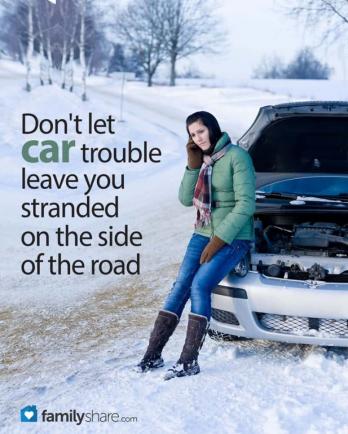
Cars don't just work. You need to ensure that your care receives regular maintenance. If you want your car to continue working, read the owner's manual, follow the maintenance schedule and keep safety supplies in your vehicle.
Safety supplies
Small floor jack
My car came with its own jack, but it was useless for changing the tire. The floor jack has been a safer choice for this purpose.
Four way lug wrench
This makes removing the lug nuts much easier than the one provided by the manufacturer.
Wheel chocks
Your car may have come with them, if not, add them.
Flashlight
And fresh batteries.
Jumper cables
The better quality ones are thicker. A better choice is a booster pack. You won't need a second car to help. Keep the booster pack charged.
Clean drinking water
In a gallon jug. Why not antifreeze? You can't drink antifreeze when you're stuck in the middle of nowhere.
Screwdriver
And a pair of pliers.
Tire gauge
Standard pencil types are fine.
Additional items to consider
Blanket
For protection or spread it out when you're working on the ground.
Work gloves
You may also want to consider latex gloves.
Leatherman
Or other multi-purpose tool.
Wet wipes
Great for cleaning up after working on the car.
First aid kit
Don't forget to check regularly for expiration dates on its contents.
Fire extinguisher
Look for one designed for automotive use.
Duct tape
(not duck tape)
Regular and pre-trip inspections
Tire wear
Passenger vehicle tires have a built in tread wear indicator. You can find their locations where you see "TWI"� or an arrowhead on the sidewalls. Look across the tread and if you see the raised hard rubber bar, it's time to change the tire.
Tire pressure
Check monthly, with a gauge, not your eyes, on cold tires. The recommended tire information label is located either on the back edge of the driver's door or on the driver's door jamb or check your manual.
Flat tire
Most flats are the result of the air leaking over time. If you discover a flat tire, you should already know how to change it since you located the tools, spare and practiced when you brought your car home. A blow-out is uncommon and most likely to occur when a tire has not been properly maintained or driven while low on air.
Tire rotation
Rotate your tires as recommended in your manual and check your brakes at the same time.
Wiper blades
Inspect at least every six months and replace when they are worn and/or cracked. Check your manual for proper replacement blades.
Oil
Check when your car is warm and level. A good time for this is when refueling. Don't add more than needed as this may damage the engine.
Coolant
Check the coolant recovery tank and maintain the water at the COLD water mark when your engine is cold and the HOT mark when the engine has been running. If you're not sure, don't add coolant when the car is hot. Burns may result. Also stay away from the radiator cap when the car is hot. When your car is overheating, pull over and turn off the car. If you continue driving, your vehicle could catch on fire. Do not attempt to open the hood or radiator cap if steam is coming from under the hood.
Washer fluid
Keep it full. You never know what may be thrown at your windshield when traveling.
Brake fluid
The reservoir is usually clear and marked on the outside with the full and add levels. This is usually low for one of two reasons. Either you need new brakes or you have a leak. Always use the proper brake fluid, as discussed in your owner's manual. Filling the fluids won't fix the problem and could result in brakes malfunctioning; you may not be able to stop. Fix the problem!
Belt(s)
Have your flashlight handy. You may need it. Check for cracks and missing chunks. It should not be glazed (shiny from slipping on the pulleys).
Hoses
Check these when the engine is cold. Squeeze them. They should not feel mushy or brittle. Ensure that they aren't swollen around their clamps and look for signs of leaking coolant.
Battery
Ensure that the battery is held in place by its hold down. Also check the connections. They should be tight and free of fuzzy white or green corrosion.
Jump starting
Check your manual for the best method for accomplishing this task. It is no longer recommended for the negative lead to be hooked to the negative post of the dead battery. Most modern cars have a place specifically marked for this lead.
In addition to maintaining the mechanical parts of the car, you should keep your car clean. It is important for proper function and value. Keep the inside clean with regular vacuuming and a damp cloth. Do not use bleach on your seat belts. This may weaken the belts and they may not protect you during an accident. Use only mild soap and lukewarm water. Clean the glass regularly with a liquid glass cleaner. Keep the outside clean of dirt and debris. This will lengthen the life of your paint and protect against deterioration due to rust. When in doubt, read your manual.

